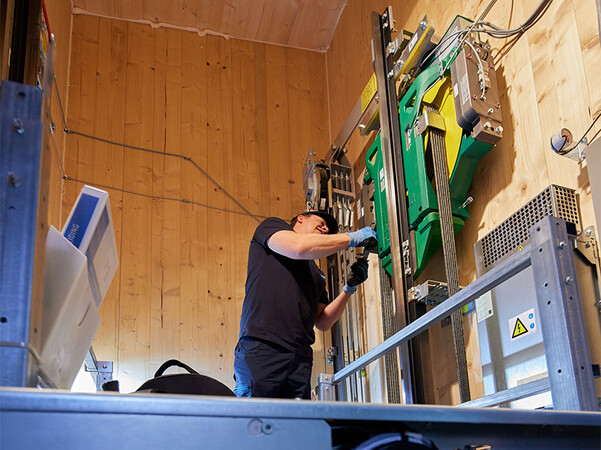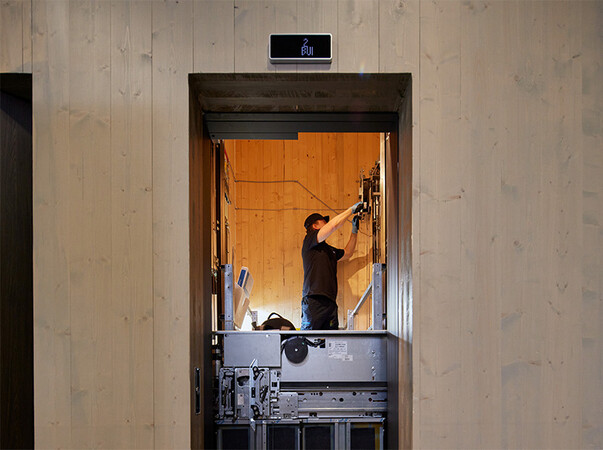Sustainable mobility meets wooden construction
There has been a renaissance in the use of wood in building in recent years. This is a sustainable trend that for Kone opens up fascinating possibilities for the lift sector.
By Stephan Hindemith
The increasing demand is above all evident in the context of sustainable construction and building extensions. This is because the use of wood has opened up new opportunities with regard to ecological aspects and above all represents a statically advantageous building material when it comes to heightening buildings. The basic planning related to the lift remains the same in the case of wooden construction.
Building code regulations, such as state building codes and the lift standard EN 81-20/50, must be observed. Special attention must be paid to the interfaces between the lift and building to ensure the guide rails and lifting hooks are securely attached. Careful planning is indispensable.
Technical subtleties
 The MonoSpace 500 DX from Kone is to be seen in the photo. The lift is installed in the Floating Office in Rotterdam, where it travels to three stops. The Floating Office is the largest floating office building in the world made completely out of wood. Photo: © Kone
The MonoSpace 500 DX from Kone is to be seen in the photo. The lift is installed in the Floating Office in Rotterdam, where it travels to three stops. The Floating Office is the largest floating office building in the world made completely out of wood. Photo: © KoneThe attachment of the lift in the wooden shaft depends on several factors, including the wooden product used, its wall thickness and the specific characteristics of the lift, such as nominal load and car dimensions. Varying wooden designs are conceivable though cross-laminated timber is usually selected. This material offers both great strength and dimensional stability and simultaneously meets the ecological needs of modern construction projects. In addition, cross-laminated timber boasts a high degree of prefabrication.
Kone has developed innovative attachment solutions that not only guarantee safe installation but also guarantee the optimal functioning of the lift. Standard solutions are available up to a nominal load of 1000 kg but attachment solutions exceeding this are conceivable.
Since wood is a soft building material, additional measures have to be taken to protect the surface of the wood during the life cycle of the lift – and as a result meet the requirements of the lift standard EN 81-20 regarding observance of the maximum permissible deformation of the shaft walls. One example of a solution is using special wooden screws combined with load distributing metal panels.
Fire protection as crucial aspect
Another crucial aspect is fire protection, which can require special attention in the case of lifts in wooden shafts. Positioning the shaft to ensure that no building law fire protection requirements arise is always advisable. If this cannot be avoided, the shaft must be clad in non-combustible materials.
In this case, fire protection requirements for the landing doors also apply. A formal regulatory gap exists here: the applicable standards regarding the fire resistance of landing doors (EN 81-58 or DIN 18091) prescribe exclusively concrete and brickwork as potential materials for lift shaft walls.
This deviation should be discussed in advance with a fire protection expert in order to define an appropriate solution. For example, this could be exceptional permits for the use of landing doors certified according to EN 81-58.
Technological advances and ecological responsibility
 Photo: © Kone
Photo: © KoneLifts in wooden shafts embody an important advance towards sustainable mobility. Thanks to meticulous planning and the use of innovative technologies, new standards have been set for safe operation and environmental consciousness.
These solutions contribute to minimising ecological footprints and improving the quality of life in urban areas. An important step towards the improved compatibility of environmental protection and modern infrastructure.
The author is Customer Solutions Engineering Manager DACH (Germany-Austria-Switzerland) at Kone.
Wooden construction ratio in Germany: In 2023, the wooden construction ratio in Germany – the number of buildings approved in which primarily wood was used for construction - continued to increase both in the new construction of residential buildings as well as in non-residential buildings.
In the case of new construction, this was 22 percent in 2023 and in the case of non-residential buildings - including office, administration and business buildings, hotels, agricultural operational buildings, factories, schools, nursery schools, sport halls - it increased to 23.4 percent.
This is according to the "Situation report carpenters/wooden construction 2024", which was published by the German Wooden Construction Association in mid-2024.
kone.de

























Write a comment